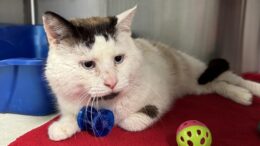Landscaping for wildlife can restore critically needed habitat and beautify your yard at the same time. Many excellent native trees, shrubs, and vines offer four seasons’ interest with their fragrant flowers, eye-catching fruit, brilliant fall color, and sculptural forms in winter. The same plants can attract a diversity of wildlife with the food, cover, and nest sites they supply.
Selecting Plants
Select plants that provide a year-round source of food
Many woody plants produce soft mast (fruit) or hard mast (nuts) that provides food for both birds and mammals. When selecting plants, choose a combination that will supply food throughout the year. For example, blackberries and raspberries provide fruit in summer and are consumed by catbirds, chipmunks, rabbits, and other wildlife present in your yard at that time. Dogwoods, mountain ash, and spicebush produce fruit in late summer and early fall and are an important food source for fall migrants.
Make sure to include some plants that retain their fruit through winter into early spring, the time of greatest food scarcity. These plants generally produce fruit that is not highly preferred, so the fruit is not consumed during the fall when other foods are abundant. Examples are hawthorn, crabapple, holly, highbush cranberry, and staghorn sumac. They are excellent plants for wildlife because they offer emergency winter food, and some, such as sumac with its red fruiting spikes, can add structural interest to a bleak winter landscape. The table (at bottom) in this fact sheet lists the fruiting period for many trees, shrubs, and vines.
Oaks, hickories, beech, and other trees that produce nuts provide food for mammals like squirrels, chipmunks, and deer, and for birds such as blue jays. These are often large trees, which also offer shade from the summer sun and nest sites for many birds. Many other plants, such as grapevines, provide multiple benefits including an abundant food supply, dense cover, and nest sites.
Although we often associate butterflies with wildflowers instead of woody plants, the larval caterpillars feed on a number of woody species. For example, tiger swallowtail caterpillars feed on the leaves of cherry, willow, and sassafras trees; and the spicebush swallowtail, true to its name, feeds on spicebush leaves. By providing a food source for the caterpillars, you will attract more butterflies to your flowers.
Select plants that provide cover and nest sites
Cover is a key ingredient in the success of your wildlife garden. In winter, wildlife species need shelter from the cold and wind. Evergreen trees and shrubs make some of the best shelters, especially those that keep their branches close to the ground. These evergreens give better insulation than plants without branches on the lower part of the trunk. They provide shelter for many types of wildlife, particularly if they are located on the northwest side of your lot where they block cold winds.
Evergreen trees, such as pines and hemlocks, and evergreen shrubs, like rhododendron and holly, make safe, year-round retreats where birds and small mammals can hide from predators and be protected from inclement weather. Deciduous shrubs with dense branching habits also make good cover. Examples are raspberries and blackberries; lilacs (which readily sprout suckers); red-osier, gray, and silky dogwoods; and elderberries. Many of these shrubs also produce berries that wildlife readily eat. Diverse types and sizes of cover plants are useful to include in your landscape plan, because individual species of wildlife have different preferences in the amount and location of cover.
Hawthorn and dogwood
Fallen trees provide cover for salamanders and small mammals. Brush piles and rock piles are sources of cover, nest sites, and den sites for many wildlife species. A trailing ground cover, such as a ground rose, or a vine such as Virginia creeper can gracefully camouflage your brush or rock pile, blending it with other landscape features while providing an additional source of food and cover.
Nesting places are vitally important for wildlife. Trees and shrubs that offer cover from predators and inclement weather also serve as sites for birds to build nests and raise their young. Tree cavities in both living and dead trees provide nest sites for a variety of species including woodpeckers, nuthatches, chickadees, flying squirrels, and gray squirrels. When nest cavities are scarce, cavity-nesting species will often use birdhouses and nest boxes. Consequently, if cavities are in short supply, you can enhance the habitat for cavity nesters by adding nest boxes.
Designing Your Landscape
As you design your landscape, let nature be your guide and try to copy what you see in nature. Plant trees and shrubs in groups instead of as isolated individuals. Plant corridors to connect islands of trees and shrubs with other natural areas. Whenever possible, plant combinations of tall trees, smaller trees, shrubs, and herbaceous plants together. This is important because different types of wildlife will find food and cover at varying heights.
Protect what is there during building
If you are building a new home, there are probably trees, shrubs, and vines already established on the property. Before building, you should determine which of these plants you want to protect during the lot-clearing process. Talk with your builder about the importance of preserving an assortment of different plants for wild species, including dead trees that won’t be a safety hazard. Either rope off areas of your lot or mark plants you wish to be spared. Include plants that can give year-round cover, food, and shelter.
Trees are often damaged during building. Bulldozers can damage tree roots while compacting the soil, making it impossible for oxygen to reach the root cells. The result is plant injury or death. Piling soil more than 3 inches above the original ground level around the trunk can also block the oxygen supply. In addition to protecting trees from root damage, you will need to shield trees from bark injuries. For more information on protecting trees during building, see “A Guide to Preserving Trees in Development Projects”, available from your county extension office.
Questions to Ask When Planning, Selecting, and Planting
To avoid problems, there are questions you should ask nursery personnel when you select plants and develop your landscape plan.
Will this plant produce fruit?
You may be selecting a plant because of the value of its fruit for wildlife and be disappointed to discover it does not produce fruit. Many ornamental trees and shrubs have been bred to produce no fruit. For example, ornamental fruit trees, such as flowering cherry, flowering peach, or flowering plum, usually produce only showy flowers and no fruit.
Will this fruit tree, nut tree, or small fruit shrub need cross-pollination with a plant of a different variety to yield a crop?
Many apple trees need cross-pollination with a different apple variety to bear fruit. Most nut trees yield a crop only if a tree of the opposite sex is planted nearby. Holly, sumac, and spicebush require both sexes to set fruit. Thus it is best to ask about pollination requirements when you purchase your plant.
Will this plant be hardy in my area?
Winter climate zones in this state are zone 5 (average minimum temperature -20° to -10°F) and zone 6 (-10° to 0°F). Your area may include microclimates where temperatures may be colder or warmer than these zones. Your county extension office can tell you the temperature range for your area.
How much moisture does my plant need?
It’s important to determine how much moisture a particular plant requires so that it will thrive where you plant it. If you establish a native plant in its preferred site, then watering and fertilizing beyond the first year may not be necessary. Mulch the area under the canopy to conserve water and maintain a consistent root temperature.
What will the ultimate dimensions of this plant be? How much space will it need?
It is good to site a plant where it can reach normal size without excessive pruning. Plants placed too close to buildings or driveways may not grow well or live long. Nursery personnel can tell you what the mature size will be.
Which exposure is best for this plant (north, south, east, or west side of the house)?
Some plants need a shady, cool location on the north side and do poorly in the warmth of a southern site. Others require full sun and protection from prevailing winds. Fruit and nut-bearing plants normally need full sun to produce a good yield. Most nurseries can tell you how much sun your plant will need. You can also observe the environment where the plant grows in the wild, or consult a native plant book for cultural information.
What type of soil does this plant prefer? How alkaline or acidic should the soil pH be for this plant?
Types of soil include loam, sandy, or clay soil. You can find out what soil type and pH your plant needs from the nursery where you bought the plant. You can determine the pH of your soil by submitting a sample to your county extension office for testing.
How should I plant and care for my new plant?
Upon request, most nurseries will supply information about how to plant, water, and nurture your new plant so that it will thrive.
For Further Information
For additional information and sources of assistance, see:
Pennsylvania Wildlife: Wildlife-Habitat Relationships
Pennsylvania Wildlife: Managing Habitat for Eastern Bluebirds
Pennsylvania Wildlife: Meadows and Prairies: Wildlife-Friendly Alternatives to Lawns
Pennsylvania Wildlife: Attracting Hummingbirds
Pennsylvania Wildlife: Gardening for Butterflies
Pennsylvania Wildlife: Managing Habitat for Eastern Cottontails
Pennsylvania Wildlife: Neighborly Natural Landscaping: Creating Natural Environments in Residential Areas
Pennsylvania Wildlife: Winter Bird Feeding: The Basics
Pennsylvania Wildlife: Managing Habitat for American Kestrels
Pennsylvania Wildlife: Water for Wildlife: Bird Baths and Backyard Ponds
Pennsylvania Wildlife: Vernal Ponds: Seasonal Habitats for Wildlife
Pennsylvania Wildlife: Riparian Buffers for Wildlife
All are available from your county extension office.
Authors: Ursula Sherrill, former wildlife extension assistant, and Margaret C. Brittingham, professor of wildlife resources
Acknowledgment: Partial funding for this fact sheet was provided by Pennsylvania’s Wild Resource Conservation fund.
This educational blog is a series of informative articles from the Penn State Master Gardeners volunteers plus news concerning the group and their activities. For more information, click here.












































